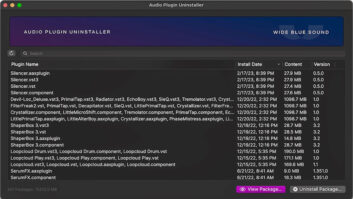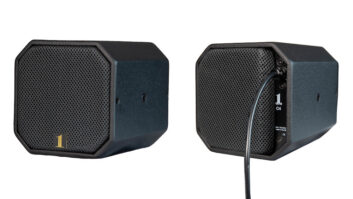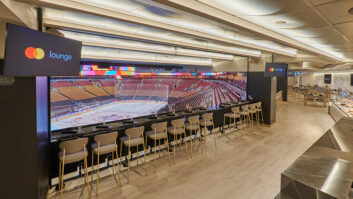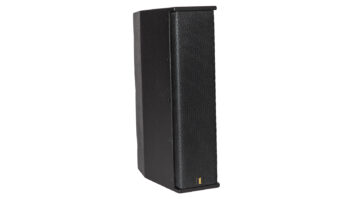ADVENTURES IN SURROUND MIXING
Everybody in the industry seems to be talking about 5.1, but how many engineers out there are actually doing surround mixing on a regular basis? A number of studios are building and retrofitting control rooms to handle multichannel playback, but others are more cautious, waiting to see if the volume of work will eventually overtake the hype. Everyone’s excited about this or that DVD, but how many people do you know who actually have a decent surround setupintheir homes? DTS discs are out there, and DVD-Audio is on the way, but does the public understand this? And why are record companies being so tentative about their DVD-A rollout plans?
How many people out there are truly qualified to do authoring for 5.1, and will the dearth of same create a logjam when the floodgates for DVD-A products open?
It all feels a little bit like the early days of digital recording, when there was a palpable excitement in the air, well-spoken zealots announcing that the future had arrived, and plenty of healthy skepticism in some quarters. Here, of course, the studio-owning naysayers are not arguing that surround technology is suspect (as many believed/believe about digital), but that there isn’t a sufficient market yet to warrant investing in the necessary technology. This much is clear, however: DVD/surround is coming on strong. If it’s not a steamroller yet, it’s at least a street tank, firing volleys at tradition as it rumbles down the middle of the road. Conventional stereo recording isn’t going away anytime soon-just as analog didn’t disappear-but surround is the new wave, so swim lessons are recommended.
Recently we spoke with a cross-section of engineers who have been involved with surround mixing (in Los Angeles, Nashville, Chicago and New York) to learn some of their techniques and to hear their thoughts about the burgeoning field.
Nathaniel Kunkel
IN LVE WITH THE CENTER
L.A.-based Nathaniel Kunkel, whose credits include engineering work with James Taylor, CSNY, Linda Ronstadt, Little Feat, Bon Jovi, Lyle Lovett and many others, has done a number of projects in 5.1, including the music for Robert Altman’s latest film, Dr. T and The Women, in which Richard Gere plays a gynecologist.
“Lyle Lovett did all the music, which we recorded and mixed in 5.1 at Conway [L.A.] in Studio C,” Kunkel says. “We did it a little differently than a normal soundtrack. Lyle wanted all the musicians to watch the movie as we were cutting it, but not a lot of the music was scripted. The themes, which were mostly by Lyle, bassist Viktor Krauss and pianist Matt Rawlings, were written, but then the band actually improvised the music to the picture, as opposed to sort of calculating exactly how many bars and beats at what tempo it was supposed to be to make it work. It actually went incredibly fast-way faster than a lot of movie scoring projects I’ve seen-mostly because the musicians were so good, and because they’re a band they have this intuitive relationship with each other.”
It was a relatively small band-two guitars, bass drums, fiddle and steel, keyboards-and some cues required fewer players. Kunkel says, “We set it up exactly like we were doing a normal record, and for the entire recording process we stayed stereo and then as soon as we went into mix mode, we went into 5.1. But I delivered all my stereo mixes as fold-down to the 5.1. And I was always thinking of the 5.1 during the recording. For instance, I recorded all my ambience and drums as LCR.
“My concept for doing 5.1 is to do all the things I wanted to do with stereo but was never really able to-to bring things out more to the left and to the right; pull things out to the side a little more,” he continues. “So a lot of times what I try to do is a regular music mix, but instruments that are predominantly in the center I will reinforce in the center speaker, and then things that are on the left or the right I might try to pull a little more to the left or right by putting them into the surrounds. I didn’t put anything only in the center channel, but certainly the voice [there is one song with a vocal] and the bass and the kick drum and the snare drum were predominantly center channel, and then I would diverge them into the left and right to make it sound a little more natural so the mix didn’t change so much as I moved around the room.
“I’m someone who really likes the center speaker. I know a lot of my friends and colleagues don’t dig the center speaker as much as I do. I’m not sure why, but I feel like I’m able to get real clarity of the things in the center without them being disproportionately loud. And I’m also able to get much better panning accuracy between the left and the center, so all of a sudden I have this space I can play with texturally, and put small percussion instruments, or reverb tails. And when you have to use a phantom center, a lot of that stuff just gets smeared out.
“For the rears I put mostly ambience, but George Massenburg hipped me to something Chuck Ainlay does, which is put the vocal in the center speaker and also in the surrounds, to kind of pull it a bit into the center of the room. But mostly I used the surrounds for reverb returns or, if I had the fiddle all the way on the left and the steel all the way on the right, sometimes I would also pull them into the surrounds a little bit just to get them more out to the sides so I had more space for the background singers.”
Kunkel raves about TC Electronic’s new System 6000 effects package, designed specifically for 5.1 mixing: “It was so good I didn’t send it back,” he says with a laugh. “They gave me one to use and I called them and said, ‘You can either call the police and say I stole it, or you can write up an invoice with the serial number, because it’s not leaving!’ It’s got four engines in it; each engine is capable of eight channels of 96k/24-bit. onboard it has eight channels of AES/EBU, and then you can add two channels of A-to-D/D-to-A converter to it, so you can have eight channels of analog I/o and eight channels of digital I/o. All of the analog and digital I/os are independently assignable to any input or any output of any engine. Then, in each of those engines you can load up stereo or 5.1 or 7.1 programs, and whatever type of algorithm you load into it is how many inputs and outputs are available on that engine to be picked off of. It’s based on their VSS algorithm-the same thing they have in the M3000-and they also have a multichannel Finalizer in it, which I’ve heard is totally incredible, but quite frankly I haven’t had a chance to take it off the reverb program yet.
“So you can create a 5.1 environment and then you have four inputs that you can localize anywhere you want. I ended up using two engines and running two 5.1 reverbs, since I had to print stems and I wanted the reverbs to be identical, but I wanted the vocal reverb and the drum reverb to be separate. The interface is really easy. It’s a touchscreen with moving faders, so there’s no buttons and it’s so quick-it’s like a 700-megahertz Windows NT. There’s a one-rackspace Windows box and a two-rackspace unit, which is kind of like the M5000, and they talk via Ethernet. It’s fantastic.”
Kunkel used Pro Tools as his record and mix medium; he delivered a hard drive to the stage as his final delivery. “First they asked me to deliver it on DA-88,” he says, “and then I found out they were going to transfer that to Pro Tools, so I figured instead I would mix it to Pro Tools and give them a session that represents each reel, and then they could just plug the hard drive in and load it, and it would be two generations less. It worked out really well, though the music editor called me and said, ‘God, there’s a lot of center speaker on some of these cues.’ But some of those cues are only bass, and bass is usually in the middle, so that made sense. But it still scares people.”
The mixing environment is obviously important in surround work, and it’s interesting to note that Kunkel says he’s found that 5.1 mixes he’s done have not translated well from one system to the next. “I’ve mixed 5.1 at Conway and at Skywalker Ranch and I’ve mixed it at The Site [in Marin County], and I’ve never had everything translate that well to another system. I remember doing a mix at Skywalker and then bringing it down to a surround conference down here and it was totally different. The bass management was bizarre. I don’t know what the problem is, but I’m concerned about it.”
As an engineer who mostly works on music CD projects rather than film, Kunkel would like to see more surround work in that area “because obviously there’s enormous potential to start doing really interesting stuff with surround on music-only projects. I mean, we can really do whatever we want, in a way, as long as it’s good. I think the worst thing we could do to 5.1 is to say that there is any rule. There are mixers who are putting voices in every speaker. There are some people who can’t stand that. But I think we should try it all.”
Jake Nicely
IISIDE THE BAND
As one of the first engineers in Nashville to get involved with surround mixing, Jake Nicely, owner of Seventeen Grand Studios, has seen interest in 5.1 skyrocket during the past two years. And now he’s reaping some of the financial rewards for being a pioneer. Recently he was assigned two DVD-Audio remix projects that are set to be among the first such releases by Warner Bros. in the fall: one by the vocal group Take 6, which is a 5.1 remix of their classic first album, along with bonus tracks from the second and third Take 6 discs; and the other a surround version of Bela Fleck’s brilliant last album, Tales From the Acoustic Planet, Vol 2: The Bluegrass Sessions (the recording of which was covered in Mix, September 1999).
In the case of the Fleck disc, which put the banjo great together with top Nashville bluegrass pickers Sam Bush, Tony Rice, Stuart Duncan and Mark Schatz, and guests such as John Hartford and Vassar Clements, Niceley decided that the DVD-A work could be done most efficiently by keeping the project in Pro Tools throughout, since it was originally recorded that way by engineer Bil VornDick, and Fleck has a setup in his home.
“I went out to Bela’s house, where he has his little studio setup, and he had installed the Smart Pan Pro plug-in on his Pro Tools, which allows you do a 5.1 matrix,” Nicely says. “He’d already been experimenting with surround and listening to things, and he had an idea of how he wanted the whole project protrayed: He wanted it to be as if you were standing in the center of a bluegrass jam session and all the players are around you. So that’s what we went for.
“He would work on it and I’d come out and listen and we would work on it together and make decisions and try different things and experiment. Ultimately we decided that it would be better if we brought the project back to the studio here [Seventeen Grand], and I upgraded my Pro Tools system to match his. The limitations at his place were primarily acoustic: His studio is a home studio, and it had all of the inherent limitations of being in someone’s home; it wasn’t built acoustically. Whereas here we had a control room that was tried and true. We had done several surround projects here and knew what to expect.”
Using the Pro Tools system for 5.1 was new to Niceley and he notes, “It was definitely a learning experience for me. I’m used to having a console with a panner that works a particular way and I’m used to having access to outboard gear that works a particular way, and by not having those things I had to try to adapt to the Pro Tools environment, because we decided to use the Pro Tools plug-ins [for effects, etc.] too. The disadvantages of using the plug-ins, as opposed to the real hardware, weren’t much; the plug-ins sounded good. It took a long time to work that way, but it ended up sounding good. Bela emphasized from the beginning that he was interested in learning how to use his equipment better, and if he’s paying for this-and he is; he’s the artist and it’s coming out of his pocket-then he wants to learn something along the way. So not only is he paying for a project; he’s paying for an education. So there was a lot of value in staying with the Pro Tools system. But we still needed to come to an acoustically correct environment to make a commercially viable product. I don’t think we could’ve gotten it right at his house.”
Because of the unique perspective Fleck wanted to achieve with the surround mix, there was more discrete localization required than on most music projects, “but you don’t want to make it so discrete that it sounds disjointed,” Nicely notes. “It still has to meld and feel like you’re in an acoustic space; there has to be an environment. So there is information from each of the instruments in each [of the main channels]. I used the center channel mainly to anchor the string bass, and I also used it to kind of help position whatever happened to be in the left and the right, as well. So I was creating a 360-degree environment. It’s like there’s a natural bleed, which is the way you’d hear it if they were standing around in a circle.
“It’s interesting when you start to rely on the rear speakers to handle as significant material as the front speakers,” he adds. “It remains to be seen how it will translate into some of the more inexpensive home systems that have little satellite speakers in the rear, but most of the ones I hear sound pretty good. I’ve heard this mix in a few different places, such as at the CES Show in Las Vegas, where it was in several different booths as part of a sampler disc Warner Bros. made to promote DVD-Audio. I heard it at the Toshiba booth and Panasonic and even in a car, and it sounded just like what I expected. That’s great material no matter how it’s released, but by having it in 5.1 you really get to hear every little nuance of every instrument.”
The first Take 6 CD was originally cut on a 3324 by engineer Don Cobb. Not surprisingly, remixing for 5.1 gave Nicely the opportunity to create an interesting dimensional image of the six singers spread around the soundfield. But again, he cautions, “you still have to create a coherent acoustic space, and in the case of a record that a lot of people know and love, you have to be faithful to the original mix to a large degree or it won’t sound right to people. You have to be respectful; you can’t just have everything all over the place.”
That doesn’t mean there was no room for creativity, however. “There’s a song on there called ‘I L-o-V-E You’ that was 48 tracks,” he says. “It had multiple voices, plus they used their voices to sound like instruments. They had two passes for each singer-the first was for the primary vocal, and on the second pass they would double the part but also they might change the part very slightly here and there. In the 5.1 mix, I separated those two parts and flipped the doubled part to the opposite speaker, so if someone was predominantly in the left front, then their double would be in the right rear. Then I also used a lot of very tight stereo delays and some longer delays to create even more space. Everything was tempo-mapped and there’s a lot of panning going on in the Take 6 stuff, particularly when they’re imitating instruments. I have that flying all over the place. ‘I L-o-V-E You’ is like a roller-coaster ride. At the end of that you’re exhausted,” he laughs. “But that track was more the exception; the rest is more straightforward, though hopefully still fun to listen to.”
Though Nicely is certainly appreciative of the label work coming his way, he believes that for DVD-A to really take off, the record companies are going to have to quickly move beyond putting out mostly remixed catalog releases. “Unfortunately, I think the record companies are missing the demographic,” he says. “I think they’ve assumed that it’s going to be the 30- and 40-plus age range-the breadwinners who are buying big home theater systems-when in fact it’s going to be a lot of younger people. High school and college kids want surround. They’re pretty sophisticated and they like new things; they like gadgets and high-tech stuff. And they don’t want their parents’ music. I think the record companies are missing a huge opportunity by not releasing current material. I mean, everyone’s excited that there’s a Beatles surround mix [Yellow Submarine], and the Eagles disc [Hell Freezes over] has sold a lot of copies. But you know, if it’s going to become the next thing, they’re going to have to start putting things out for the younger crowd. I think it would be wise to start thinking about simultaneous releases-putting it out as DVD and CD, or just DVD, which would be playable in stereo, too.
“With DVD-A, in the mastering process, like if you’re working in a Sonic Solutions system, you get to determine how the stereo is created in terms of how the rears [of the 5.1 mix] are brought to the front-maybe down a few dB, or whether they’re in phase or out of phase. And the same with the center and the sub: You get to direct how the stereo is created, and that information is programmed into the DVD disc so when it gets played back in a DVD-Audio player, the stereo plays back the way you decided, instead of it being an arbitrary downmix, like with Dolby Digital. And that stereo mix will be available at the headphone jack on a DVD player. It’s really a very versatile platform and we’re just beginning to learn what we can do with it.”
Chris Steinmetz
PERCUSSION POWER AND MYSTIQUE
In mid-1998, 5.1 arrived with great fanfare at Chicago Trax, then and now one of the leading music recording facilities in the entire Midwest (see Mix, November 1998). owner Reid Hyams built the studio’s surround room from the ground up, centered around an AMS Neve Capricorn digital console. Music VI, as it was called, was designed to be the crown jewel in a studio complex that also included two SSL rooms and a Harrison room, a Pro Tools suite, a dub/ transfer room and a MIDI production space. Two years later, the room is still one of the most popular in the facility, but there has been a major change: The Capricorn is gone, replaced by a Rupert Neve Amek 9098i, which turns out to be a more popular and economical choice for a facility where there has not always been enough 5.1 work to justify the high cost of maintaining and upgrading the Capricorn (which was 20-bit and needed to move up to 24-bit).
By installing the analog Amek board, Chicago Trax chief engineer and director of recording services Chris Steinmetz has had to make a few changes in how he works on 5.1 projects, but he is ecstatic with the new console. “It’s been fantastic,” he says. “That board really hit the ground running. At Chicago Trax we get in a fair number of outside engineers working on things and I know they love it. I haven’t had a chance to do a full 5.1 project on it, but I’ve put up some tapes and mixed in 5.1 on it and it’s been great. You miss some of the features of a digital desk, such as independent bus routing and automating the panning. The 9098i gives you a couple of automated joysticks, and we recently installed the divergence cards, which allow you, when you have LCR, to vary the amount of the left and right so you can spread it out or into the center. on an analog board the routing is a little more complicated, so in order to get the center only, you’ve got to do some specific patching and there’s a little bit of extra work, but the sound of the board is worth it. We had looked at the Amek board before we got the Capricorn, so we already knew what it was capable of.
Probably the most exciting 5.1 project Steinmetz has worked on to date is the forthcoming retrospective of solo work by former Grateful Dead percussionist Mickey Hart. Steinmetz first worked with Hart and his longtime engineer Tom Flye on 5.1 mixes for two songs from the 1998 album Supralingua (see Mix, December 1998). Hart was so happy with the added dimension 5.1 brought to his percussion extravaganzas that he next brought his “best of” project to Chicago Trax. This diverse and ambitious DVD-A brings together tracks from every corner of Hart’s solo career-from the 1976 Diga Rhythm Devils LP, through his soundtrack work on Apocalypse Now, the haunting Dafos project, At the Edge, Mystery Box and more.
“The tapes came in on all sorts of formats,” Steinmetz says. “We transferred everything to 24-bit Pro Tools, and by the end of it we’d used 16-track analog with 2-inch heads, there was music on ADAT, there was 48-track digital, some regular 24-track and there was even some stuff we got off an old 3-track machine. It’s going to be a real interesting disc when it comes out. It’s an amazing array of percussion and sounds and grooves; it was made to be in 5.1. one of the coolest things on there is this music he did for the opening ceremony of the [1996] olympics in Atlanta. That has something like 300 drummers playing at once, and in 5.1 it’s pretty impressive.
“on the Mickey Hart stuff we focused on building the mix from the center-being inside the soundfield, as opposed to the live situations where they have the ambience in the back and are more conservative,” he continues. “Mickey’s looking for a certain power and mystique in the sound. And he loves to hear movement. one concept he verbalized to Tom and me that we tried to achieve-and I think we did-was the idea of vertical motion, instead of just left and right and around. He also pointed out that now he’s starting to think about 5.1 whenever he records. So if composers start thinking in 5.1 and engineers start thinking about miking for 5.1, that’s going to make it more interesting for everyone.”
In the great center-channel debate, Steinmetz says, “I tend not to put the bass or heavy elements in the center in part because people don’t tend to have a very strong center channel at home. I like to put some snare delay or things that would triangulate from the center to the rear speakers-something that appears in the center for the first time and then triangulates past you.”
Since Hart’s music is so unconventional, Flye and Steinmetz didn’t have to concern themselves about placing musical elements in traditional positions in the soundfield. When there’s no concern for how, for instance, guitar, bass and traps are going to be spread across the front, because the instrumentation is instead low drums, Egyptian tar, dumbek, berimbau and cymbals, there are no precepts to follow. And because Hart has always been interested in the sound environment, he was anxious to experiment with the dimensionality of the soundfield. It’s somehow appropriate that someone from the trippiest band on the planet has made one of the first great surround discs for “heads.”
Steinmetz, for one, is delighted that Hart and Flye have taken the time to lavish so much attention on moving tracks from stereo to 5.1. This is not, he says, what he’s seeing out in the greater marketplace. “one of the dangers of 5.1 right now is that a lot of labels and production companies and even artists themselves are letting their music get released in a fold-out faux 5.1 format, where they’re not actually going back in and remixing. And I’m hearing these butchered versions of songs that were never intended to be outside of a stereo field. They’re splitting it out to five channels and putting a little bass management in, but it doesn’t sound very good and that’s going to turn a lot of people off. When you’re talking about music from the past that was mixed in stereo, you have to pay a lot of respect to the original mixes. And if you do, you can come out with something pretty cool. Some of the purists were screaming about Yellow Submarine-they were hearing things they didn’t like or parts that seemed emphasized. So you’re going to get those arguments and you have to be careful. But when the new generation gets in tune with this new format, they’re so technically savvy they’re not going to be worried about it. They’ll be discovering this for themselves. Part of what’s happening now is a generational switchover: Some people who are used to having things in stereo don’t want to hear 5.1. But there are a lot of young people who love the home theater experience and they’re dying to hear more in surround.
“I did a nice 5.1 mix on a song by Sonia Dada that used [the surround] really well. It’s a real groove-oriented vocal track that is really strong. It’s got a tight groove where the subwoofer adds something to the pocket. They have three singers in the band that you can spread out nicely and get good separation. But beyond that there were some cool loops and effects that I could position in the rear speakers that were halfway back-not discretely in the rear speakers-and there were birds flying around, so there’s a point at the beginning where a bird flies from the front right to the rear left and it really feels like it flies over your head. Really, we’re going to see more and more current bands that understand the potential of 5.1 as time goes on.”
Steven Epstein and Richard King
ORCHESTRA REMAINS UP FRONT
So far, most of the press concerning 5.1 has been about pop music projects, and that makes sense since record labels are most likely to invest in singers or groups who are likely to sell a lot of “product” (as they say in the biz). But we wondered what was going on in the world of classical music, so we contacted two of the best in the business: Producer Steven Epstein, who has won the classical producer of the year Grammy twice in the past five years, and engineer Richard King, who often works with Epstein. (Both have extensive jazz credits, as well.) Epstein and King work out of Sony Studios in New York and do most their 5.1 mixing in that facility’s oxford room.
“I’ve been tracking for surround since 1992,” King says, “putting things on tape at high-bit-at least 20-bit; now we’re all 24-bit-and waiting for [Sony executives] to say, ‘okay, now is the time,’ and we can go back and reissue it all in surround.”
“Like Richard, I’m hoping some recordings I’ve done the past few years will see release in that format,” Epstein adds. “I think there is a commitment to the format here, but that’s probably a question you should put to my boss,” he adds with a chuckle.
“One project I’ve done recently,” King says, “is a record of Bernard Hermann film music that originally came out in 1996 in stereo, but [at that time] we also did a Dolby matrix surround on the CD, and now we’re going to reissue it as a discrete surround. We recorded it 20-bit, 44.1 at the time, but we’re going to bump it up to 88, and as I mix it, it will become 24 bits. So that will be discrete DVD-A. It was recorded in L.A. originally with the Los Angeles Philharmonic. It was a 48-track, and I did stems for surround for later, so now I’m just going to refine the stems that I made in ’96 for this release.”
King says that for the most part he likes to maintain the perspective of the orchestra being in front, rather than completely enveloping the listener. “on that project, the perspective is just hall ambient sound in the rears; the orchestra is all in the front. However, there are a few things that get pulled a bit outside of the front speakers, around the sides a little bit-things like harp and piano. on the Vertigo soundtrack [by Hermann] there’s some Hammond B-3 stuff that’s pretty neat, with really low chords, and for that I actually put the Leslie cabinet out in front of the orchestra, so that gets localized in the back; that sounds good.
“I’m not a big fan of things spinning around me when I’m listening. I enjoy the notion of envelopment, but not the distraction of things moving too much. I will occasionally do a thing where if I have any instruments in the orchestra right out on the front of the stage near the conductor, [in the 5.1 mix] I’ll pull them outside slightly to the sides so you get the perspective of standing on the [conductor’s] podium, where it would be very natural-sounding for the harp, for instance, to be off to his left but also slightly behind his left shoulder-but not completely out of the hall. I have also placed instruments in the hall [spatially]-offstage brass, a chorus. I could do that because they were meant by the composer to be in that position. I’ve done that in demos but never for something that’s been released.”
“I’m very interested in 5.1 and I’m also intetersted in [Sony’s] Direct Stream Digital-DSD-technique and utilizing that in a surround sound format,” Epstein says. “For me, that would be the optimum. I’m interested in it aesthetically from the standpoint of rather than resorting to gimmickry, using ambient classical surround and perhaps doing material-such as Mahler’s Third Symphony, where the offstage trumpet is really offstage-to create an accurate space. But I don’t want to be in the center of an orchestra with the brass in the back and the fabric of the ensemble torn apart. Where that sort of thing might work is with contemporary music. I can tell you this: There are several composers I know who are thinking about the possibilities that the digital surround formats offer and they’re taking that into account in their compositions, because they would like to realize spatially on disc what they’re doing in a live situation.”
While Epstein and King wait for those composers to push the oxford room to its limits somewhere down the road, there’s more traditional classical music getting the 5.1 treatment. A while back there was a Christmas in Vienna TV special. And more recently there was the soundtrack music for Ang Lee’s new film, Crouching Tiger, Hidden Dragon, which was recorded and mixed to stereo on an SSL 9000 at a studio in China-Shanghai Eastern Radio-and then brought back to New York for the 5.1. “That studio was very nice,” Epstein comments. “Actually it was more along the lines of an American pop studio, but it was still big enough to get an orchestra in there. Here again with the 5.1, you’re somewhat limited by film: You don’t want to put too much activity in the back because you need to save that for special effects. So most of what we put back there was ambient material.”
King says these sorts of projects are easily accommodated by the oxford room (which is also equipped with B&W 801 Matrix 3 speakers). “It’s set up really well for that kind of thing, and also, if you start a stereo mix on that console and later spread it out for surround, it’s very simple to do. You’re just rerouting and refining the levels.
“It’s funny,” King concludes. “When you work in surround a lot, your ear gets used to it after a while and you might even think it’s not really working-then you flip it back to stereo and see the dimension you’re missing. It’s like night and day.”







